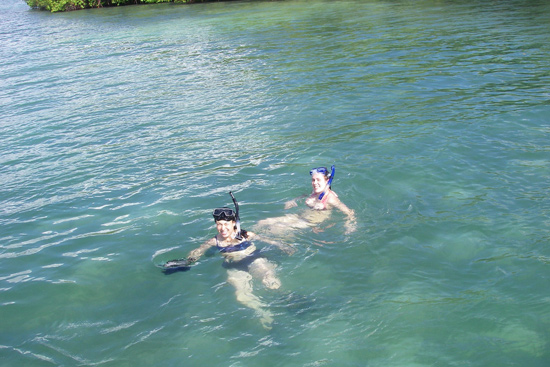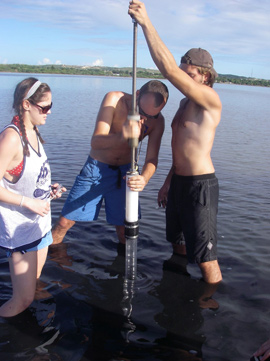Seniors Project Takes Student Researchers to Puerto Rico

In January, Hannah Hastings ‘08 and Andrea Pain ‘08 collected seagrass from the ocean floor to study nutrient content in a dinoflagellate-rich ecosystem off the southwest coast of Puerto Rico. The seniors returned to Wesleyan and analyzed their samples for carbon, nitrogen and phosphorus levels. They discovered a high ratio of nitrogen to phosphorus compared to the normal ratio in the ocean.
”We discovered that high dinoflagellate concentrations are directly associated with elevated nitrogen to phosphorus ratios,” Pain said during Part I of the Earth and Environmental Science Departments Senior Seminar Research Project colloquium March 6. Part II of the colloquium is scheduled for March 25.
Hastings and Pain were among 15 students and two faculty members who traveled to Puerto Rico Jan. 7 to 13 to carry out multiple research projects on the island. These students are enrolled in the E&ES 398 course, Senior Seminar, the capstone course for the E&ES major. Tim Ku and Dana Royer, both assistant professors of earth and environmental sciences, teach the class.
”This year, we chose to take the class to Puerto Rico because the island has a wide variety of terrain and different environments to study,” Ku said. ”The students come up with an original research question and the procedures necessary to answer that question.”
Ku and Royer suggest general research topics to their classes; however the students are encouraged to come up with their own ideas, too. The students break into groups of two and three, and direct their own study and analysis.
Michelle Chen ’08 and Rebecca Sorell ’08 studied the depositional history of a salt flat near the shoreline city of Cabo Rojo, Puerto Rico. The duo, along with their classmates, waded through worm-infested, mushy terrain collecting 10 sediment core samples in a lagoon. Afterwards, they dissected the core, photographed the contents and described the sediments substance.
They discovered layers of clay, shell hash, silt, salt and organic layer, within their samples, and even traces of mangrove roots, and halite, or rock salt. Halite forms in evaporated water basins.
”We think this area was once completely wet and underwater, but then completely dried out where we found the salt layers,” Sorrell explained. ”Future projects could involve comparing this lagoon to others on the island.”
Marie Brophy ’08, Sophia Kim ’08 and Miles Turner ’08 studied the geology of the Bermeja Complex, the oldest rock formation on the island of Puerto Rico. The Bermeja terrain, which is estimated to be 200 million years old, is made of serpentinite, a green rock comprised of minerals from Earths seafloor.
”Our question was, how did these rocks get to where they are today,” explained Brophy. “They could have been pushed onto land directly from the seafloor or plunged first into the mantle and then placed on the Earth’s surface through volcanic activity.”
The group studied the Bermejas serpentinite and diorite rocks through optical microscopy and a scanning electron microscope at Wesleyan and developed emplacement theories based on their studies.
 The group concluded the rocks were pushed, or obducted, directly onto land from the seafloor.
The group concluded the rocks were pushed, or obducted, directly onto land from the seafloor.
All students traveled the island together, and helped one another with their particular projects.
Every student gets to be a leader at some point, Royer explained. For example, when Hannah and Andrea conducted their seagrass study, they acted as the leaders and directed the other students to areas to collect samples.
The students pay for their own airfare, but an endowment pays for all housing, island travel, meals and research expenses.
The remaining students involved in the Senior Seminar studies in Puerto Rico will speak at noon March 25 in Exley Science Center Room 405. These groups will present their research on rainforest plants (Gabriela Doria ’08, Margo Fernandez-Burgos ’08, Dana Powell ’08, Jordan Schmidt ’08), bat droppings (Jessica Fischer ’08, Sharon Newman ’08, Ulyana Sorokopoud ’08, and mogote topography (Julius Pasay ’08).
(Photos contributed by Tim Ku)

